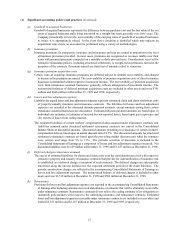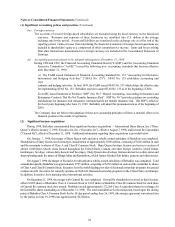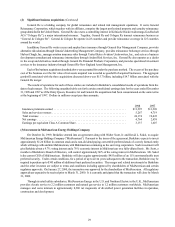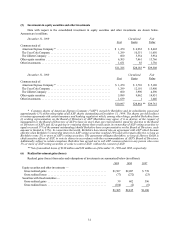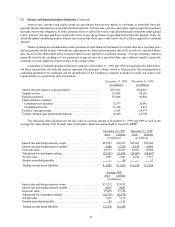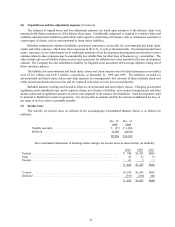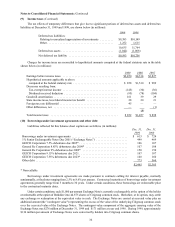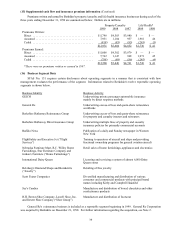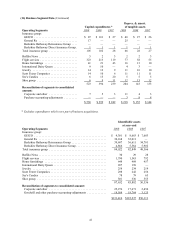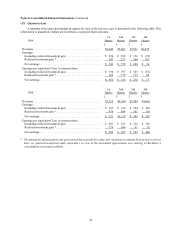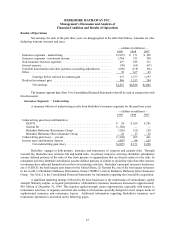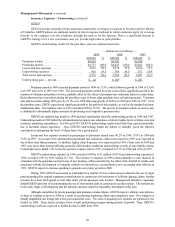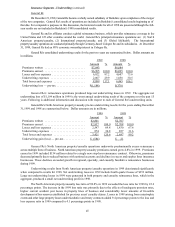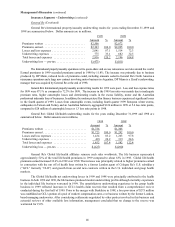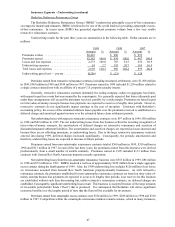Berkshire Hathaway 1999 Annual Report Download - page 38
Download and view the complete annual report
Please find page 38 of the 1999 Berkshire Hathaway annual report below. You can navigate through the pages in the report by either clicking on the pages listed below, or by using the keyword search tool below to find specific information within the annual report.
37
(10) Borrowings under investment agreements and other debt (Continued)
Other debt includes primarily commercial paper, revolving bank debt, and variable rate term bonds issued by a variety
of Berkshire subsidiaries and generally, may be redeemed at any time at the option of the issuing company.
No materially restrictive covenants are included in any of the various debt agreements. Payments of principal amounts
expected during the next five years are as follows (in millions):
2000 2001 2002 2003 2004
$522 $473 $ 28 $ 54 $ 18
(11) Dividend restrictions - Insurance subsidiaries
Payments of dividends by insurance subsidiaries members are restricted by insurance statutes and regulations. Without
prior regulatory approval in 2000, Berkshire can receive up to approximately $4.2 billion as dividends from insurance
subsidiaries.
Combined shareholders' equity of U.S. based property/casualty insurance subsidiaries determined pursuant to statutory
accounting rules (Statutory Surplus as Regards Policyholders) was approximately $44.5 billion at December 31, 1999. This
amount differs from the corresponding amount determined on the basis of GAAP. The major differences between statutory
basis accounting and GAAP are that deferred income tax assets and liabilities, deferred charges-reinsurance assumed,
unrealized gains and losses on investments in securities with fixed maturities and goodwill of acquired businesses are
recognized under GAAP but not for statutory reporting purposes.
(12) Common stock
Changes in issued and outstanding common stock of the Company during the three years ended December 31, 1999,
are shown in the table below.
Class B Common
$0.1667 Par Value
Class A Common, $5 Par Value (55,000,000 shares
(1,650,000 shares authorized*) authorized*)
Shares Treasury Shares Shares Issued and
Issued Shares Outstanding Outstanding
Balance December 31, 1996 ................ 1,376,188 170,068 1,206,120 783,755
Common stock issued in connection
with acquisition of business ............... —(1,866) 1,866 165
Conversions of Class A common stock
to Class B common stock and other ......... (10,098) — (10,098) 303,236
Balance December 31, 1997 ................ 1,366,090 168,202 1,197,888 1,087,156
Common stock issued in connection
with acquisitions of businesses ............. 168,670 (9,709) 178,379 3,174,677
Conversions of Class A common stock
to Class B common stock and other ......... (26,732) —(26,732) 808,546
Retirement of treasury shares ................ (158,493)(158,493) — —
Balance December 31, 1998 ................ 1,349,535 — 1,349,535 5,070,379
Conversions of Class A common stock
to Class B common stock and other ......... (7,872) (7,872) 296,576
Balance December 31, 1999 ................ 1,341,663 — 1,341,663 5,366,955
*Prior to the General Re merger the number of authorized Class A and Class B Common shares was 1,500,000 and 50,000,000
respectively.
Each share of Class A Common Stock is convertible, at the option of the holder, into thirty shares of Class B Common
Stock. Class B Common Stock is not convertible into Class A Common Stock. Each share of Class B Common Stock
possesses voting rights equivalent to one-two-hundredth (1/200) of the voting rights of a share of Class A Common Stock.
Class A and Class B common shares vote together as a single class.
In connection with the General Re merger, all shares of Class A and Class B Common Stock of the Company
outstanding immediately prior to the effective date of the merger were canceled and replaced with new Class A and Class
B common shares and all Class A treasury shares were canceled and retired. See Note 2 for information regarding the
General Re merger.


